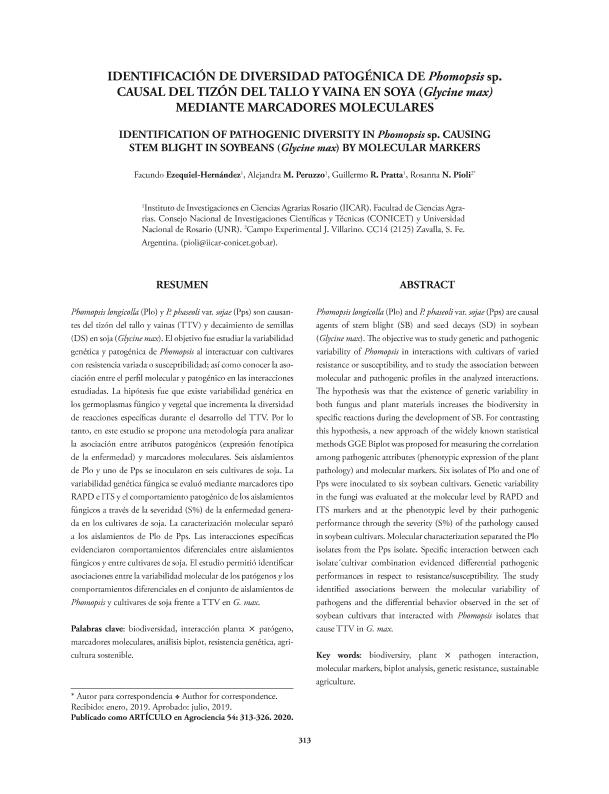Artículo
Phomopsis longicolla (Plo) y P. phaseoli var. sojae (Pps) son causantes del tizón del tallo y vainas (TTV) y decaimiento de semillas (DS) en soja (Glycine max). El objetivo fue estudiar la variabilidad genética y patogénica de Phomopsis al interactuar con cultivares con resistencia variada o susceptibilidad; así como conocer la asociación entre el perfil molecular y patogénico en las interacciones estudiadas. La hipótesis fue que existe variabilidad genética en los germoplasmas fúngico y vegetal que incrementa la diversidad de reacciones específicas durante el desarrollo del TTV. Por lo tanto, en este estudio se propone una metodología para analizar la asociación entre atributos patogénicos (expresión fenotípica de la enfermedad) y marcadores moleculares. Seis aislamientos de Plo y uno de Pps se inocularon en seis cultivares de soja. La variabilidad genética fúngica se evaluó mediante marcadores tipo RAPD e ITS y el comportamiento patogénico de los aislamientos fúngicos a través de la severidad (S%) de la enfermedad generada en los cultivares de soja. La caracterización molecular separó a los aislamientos de Plo de Pps. Las interacciones específicas evidenciaron comportamientos diferenciales entre aislamientos fúngicos y entre cultivares de soja. El estudio permitió identificar asociaciones entre la variabilidad molecular de los patógenos y los comportamientos diferenciales en el conjunto de aislamientos de Phomopsis y cultivares de soja frente a TTV en G. max. Phomopsis longicolla (Plo) and P. phaseoli var. sojae (Pps) are causal agents of stem blight (SB) and seed decays (SD) in soybean (Glycine max). The objective was to study genetic and pathogenic variability of Phomopsis in interactions with cultivars of varied resistance or susceptibility, and to study the association between molecular and pathogenic profiles in the analyzed interactions. The hypothesis was that the existence of genetic variability in both fungus and plant materials increases the biodiversity in specific reactions during the development of SB. For contrasting this hypothesis, a new approach of the widely known statistical methods GGE Biplot was proposed for measuring the correlation among pathogenic attributes (phenotypic expression of the plant pathology) and molecular markers. Six isolates of Plo and one of Pps were inoculated to six soybean cultivars. Genetic variability in the fungi was evaluated at the molecular level by RAPD and ITS markers and at the phenotypic level by their pathogenic performance through the severity (S%) of the pathology caused in soybean cultivars. Molecular characterization separated the Plo isolates from the Pps isolate. Specific interaction between each isolate´cultivar combination evidenced differential pathogenic performances in respect to resistance/susceptibility. The study identified associations between the molecular variability of pathogens and the differential behavior observed in the set of soybean cultivars that interacted with Phomopsis isolates that cause TTV in G. max.
Identificación de diversidad patogénica de Phomopsis sp. causal del tizón del tallo y vaina en soya (Glycine max) mediante marcadores moleculares
Título:
Identification of pathogenic diversity in Phomopsis sp. causing stem blight in soybeans (Glycine max) by molecular markers
Hernández, Facundo Ezequiel ; Peruzzo, Alejandra María
; Peruzzo, Alejandra María ; Pratta, Guillermo Raúl
; Pratta, Guillermo Raúl ; Pioli, Rosanna Nora
; Pioli, Rosanna Nora
 ; Peruzzo, Alejandra María
; Peruzzo, Alejandra María ; Pratta, Guillermo Raúl
; Pratta, Guillermo Raúl ; Pioli, Rosanna Nora
; Pioli, Rosanna Nora
Fecha de publicación:
04/2020
Editorial:
Colegio de Postgraduados
Revista:
Agrociencia
ISSN:
1405-3195
e-ISSN:
2521-9766
Idioma:
Inglés
Tipo de recurso:
Artículo publicado
Clasificación temática:
Resumen
Archivos asociados
Licencia
Identificadores
Colecciones
Articulos(IICAR)
Articulos de INST. DE INVESTIGACIONES EN CIENCIAS AGRARIAS DE ROSARIO
Articulos de INST. DE INVESTIGACIONES EN CIENCIAS AGRARIAS DE ROSARIO
Citación
Hernández, Facundo Ezequiel; Peruzzo, Alejandra María; Pratta, Guillermo Raúl; Pioli, Rosanna Nora; Identificación de diversidad patogénica de Phomopsis sp. causal del tizón del tallo y vaina en soya (Glycine max) mediante marcadores moleculares; Colegio de Postgraduados; Agrociencia; 54; 3; 4-2020; 313-326
Compartir



